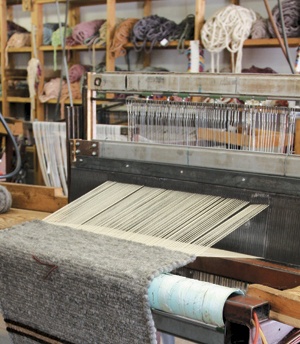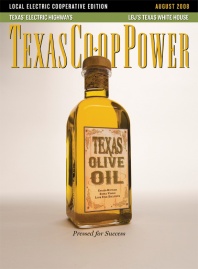At Ingrid’s Custom Hand Woven in Paint Rock, it takes a while to learn the lingo of the loom: Warp. Weft. Shuttle. Reed.
But after just a few seconds, visitors to Ingrid’s know the sounds of the loom: The whooshing of air that packs the yarn. The screeching of the reed that draws the threads tight as workers churn out custom-ordered, handmade rugs on homemade looms. All at once, the weaving process sounds like the opening and closing of sliding glass doors and the falling of bowling pins or wooden blocks.
But it’s music to the ears of Reinhard Schoffthaler, owner and operator of Ingrid’s in the tiny West Texas town east of San Angelo.
“It’s not that noisy, is it?” Schoffthaler asked above the din one January afternoon as he explained how his looms operate. “It sounds like somebody’s working.”
Mostly, the noise sounds like success at Ingrid’s, where visitors are invited to watch—and listen—as workers weave rugs on the looms, creating designs by laying in yarns of contrasting colors. Giant spools of yarn in a rainbow of colors—including apricot, midnight blue, black cherry and blush pink—line the shelves behind the looms.
Almost three decades ago, the Austrian-born Schoffthaler owned a restaurant on Long Island, New York. For Schoffthaler, a chef, the future seemed well-defined. But in 1981, in an abrupt turn of events, he bought Ingrid’s from a second cousin and his wife, Ingrid, for whom the store is named.
Every day, the 61-year-old Schoffthaler looks over his looms, which produce roughly 45,000 square feet of rugs every year. But he’s never looked back. “As fate has it, you don’t always do what you had planned,” said Schoffthaler, who was raised on a dairy farm in Austria.
Schoffthaler’s customers, such as Cindy Ruckman of Mount Vernon, Ohio, keep coming back because things do go as planned. Ruckman boxes and ships her llama fleece to Schoffthaler and then sells the rugs.
“I tell him what sizes I want and tell him to have his designers have fun and make me pretty rugs, and I’ve never been disappointed,” Ruckman said in a telephone interview.
Ingrid’s, which opened in 1979, does business with about 150 alpaca and llama owners nationwide and in Canada who send their fleece to Schoffthaler, pay him to make it into rugs and then sell the rugs themselves. The business even weaves buffalo rugs for one client.
But Ingrid’s caters to walk-in customers as well, selling custom-ordered wool and mohair rugs in the store. The wool is imported from New Zealand, and the mohair comes from the vast West Texas region, the nation’s No. 1 mohair producer. According to the San Angelo-based Mohair Council of America, West Texas trails only Africa in worldwide mohair production.
Rugs come in various sizes—from 10 inches wide to 12 feet wide by any length—and are as colorful as buyers’ imaginations. Ingrid’s carries 76 colors of dyed wool and mohair, including periwinkle and garden green. Fleece from alpacas and llamas comes complete with its own natural palette of colors. For example, alpaca fleece can yield shades of white, brown, fawn and black and features silver gray and rose gray. Llamas produce white, dark mahogany, coffee brown, brown red and appaloosa colors, just to name a few.
The different colors of alpaca and llama fleece, most of which arrives in boxes, are blended per customers’ instructions and then thrown into a blower to eliminate dust and small particles. From there, the fleece goes into a spinning machine, which turns it into yarn. First, the fleece is carded, meaning its raw fibers are straightened and smoothed. Then it’s spun around something called a jute core, which gives it extra heaviness and durability and adds a stiffness and flatness to the rug. “Without that, we’d have a blanket,” Schoffthaler said.
From there, the yarn goes to the loom. A handheld device called a shuttle—a piece of PVC pipe that weaves in yarn and looks like a tiny boat—is filled with yarn (called the weft) and shoved back and forth between the warp: strong polyester threads that run lengthwise in the loom and go up and down. Heddles lift the strings, and the air-driven reed draws the threads tight, packing the yarn.
“What you do is you put your shuttle through here,” Schoffthaler said, pointing. “Now watch, the upper strings will go down and the bottom strings will go up. Did you see that? It weaved it in.”
“We’re making one-of-a-kind items that you can’t buy somewhere else. That’s why they come here,” he said.
When Ruckman wants new rugs, she shears some llamas—one llama produces about 11/2 pounds to 2 pounds of usable fleece—boxes up their fleece and ships it to Ingrid’s. There, her boxes join hundreds of others on the shelves of a warehouse. After her fleece has been blended, blown, spun and woven, Schoffthaler mails Ruckman the end result: intricately designed rugs that she sells or keeps for herself and her family on their llama farm.
Ruckman, who last year sold a rug to a buyer in New Zealand, said at any given time, she might ship 5 to 100 pounds of fleece to Schoffthaler. He then tells her how many square feet of fleece she has, including per color. Five pounds of fleece will make about 15 to 16 square feet of rugs.
Ingrid’s rugs are reversible, and Schoffthaler recommends using both sides.
Ruckman keeps some rugs for herself, such as the 3-year-old runner inside her house that gets dog and human foot traffic. The rug looks brand-new, Ruckman said, explaining that she runs the sweeper over it or hoses it off outside.
Nobody weaves rugs like Schoffthaler, Rucker said. “He’s like a one-stop shop. I don’t know of anyone else who does what he does.”
Camille Wheeler is Texas Co-op Power’s staff writer.


